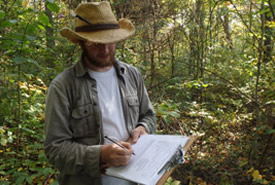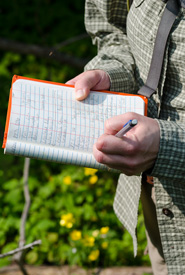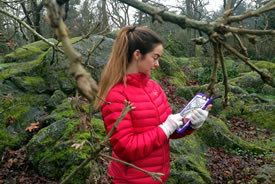NCC staff in the field

NCC reptile and amphibian technician, Louis Gagnon, records data during field variations of species at risk habitat models (Photo by NCC)
Part of a Nature Conservancy of Canada (NCC) scientist’s job is to go out to our conserved properties, potential acquisitions and surrounding areas and collect samples and information essential to our work. This information helps identify what needs to be done in a specific area to help native plants and animals thrive in their nature habitat.
With the help of Conservation Volunteers, interns and other staff members, our scientists can properly assess these areas for conservation. Like every good scientist, those at NCC rely on evidence to make conclusions about our land.

NCC's Julie Vasseur records tree species in a quadrant of Holman's Island, PEI. (Photo by Sean Landsman)
This evidence is captured using field journals: a notebook of data and samples kept by field staff at NCC, and cross-referenced with field guides.
Field guides, on the other hand, are pocket-sized books, written by scientists for scientists. Although there are many different guides, field staff at NCC have their favourites:
“We don’t go into the field without Newcomb’s Wildflower guide, The Sibley Field Guide to Birds, Wetland Plants of Ontario and a reptile field guide,” says Ali Giroux, NCC’s acting coordinator of conservation biology in eastern Ontario. “We also have a cheat sheet in the back of our field notebook for tricks and tips for field ID that we’ve learned along the way.”
Over the years, field staff have developed their own methods for effective note-taking in the field:
“I use different styles of bullets for different info I write down frequently (e.g. * = important note, - = species observed, [] = time stamp, O = GPS point, 561 = photo number),” says Liv Monck-Whipp, NCC’s conservation biology assistant. “I have their meanings written at the front or back of the book.”
This shorthand allows for quick note-taking, especially in high-activity areas with lots to see. Or in many cases, an area (especially wetlands) with lots of bugs!

Katy Fulton uses an iPad regularly in her stewardship and monitoring work (Photo by Ben Fox)
Staff have incorporated modern technology to enhance the way the take notes.
“Smartphones make some field observation entry super easy!” Says Liv. “I like iNaturalist.org’s app for recording observations when out casually, but Ontario Nature Reptile and Amphibian Atlas, EDDMapS (for invasive species tracking), eBird provide more specific kinds of observation data.”
According to Liv, apps like these allow naturalists of all expertise levels to record, explore and learn more about the land and species around them; making science more assessable to everyone.
New to field journaling?
“When in doubt write it down,” says Liv. “As my old boss used to say, ‘It takes 20 seconds to make an extra note, or three hours to get back out there to check!’”
Not sure what to record? Download NCC’s field page to take out with you the next time you go exploring. If you're going out in a group, Liv suggests putting your initials at the top of the page if sharing observations, “so if you forget something you know who to track down to ask about it!”
Field journaling is a great way to get out and explore nature and recording your findings. This is beneficial to both you and science. Observations from an area you tend to visit frequently allow you to monitor changes such as temperature fluctuations and new species sightings. By doing this over a long period of time you can see how an area will change over time. In addition, creating a personal account of your time with nature allows to you to create a personal connection to the land.
At NCC, field staff use these notes as a reflection of changes both negative and positive to an area. They will use their observations as a doctor would a list of symptoms in a patient to treat the land, conserving it for generations to come.


